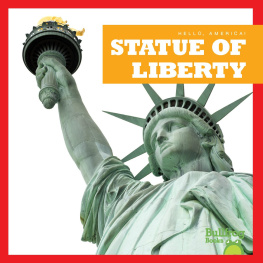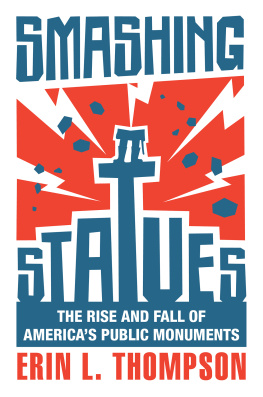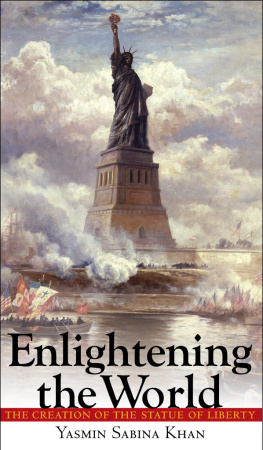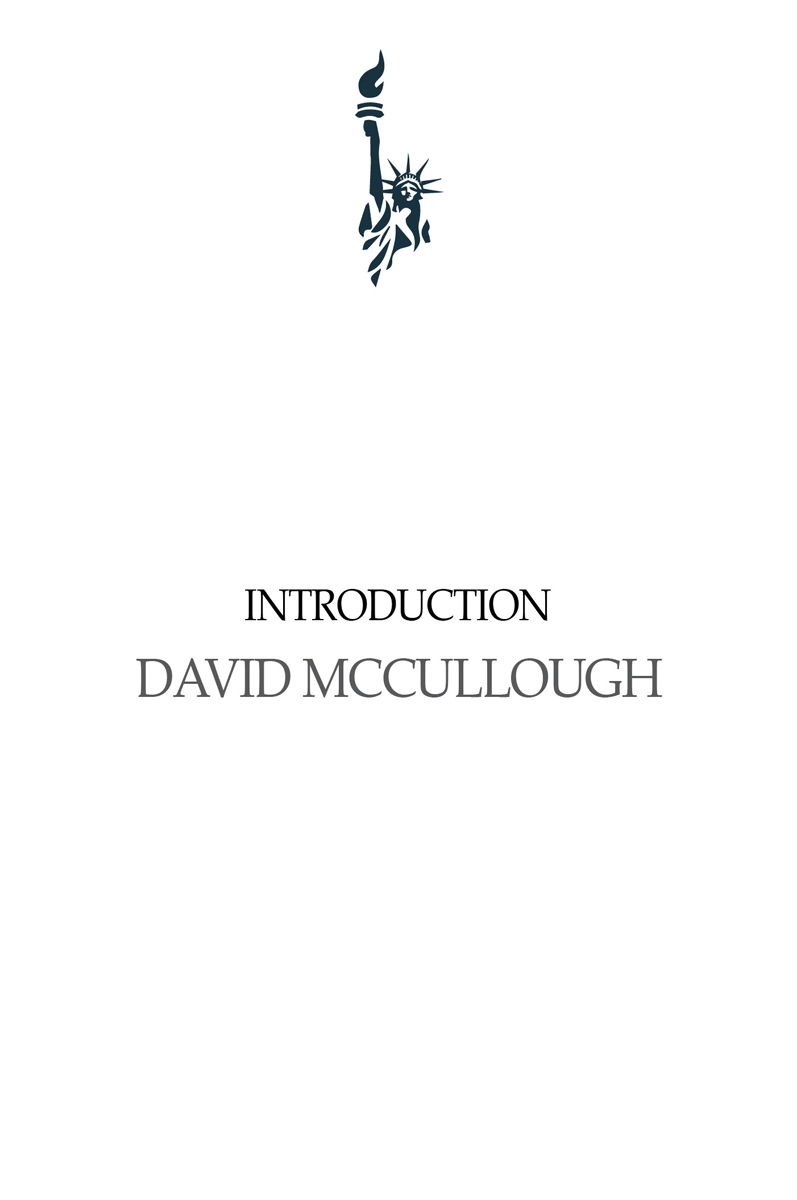Its size alone no doubt would have been enough to guarantee the Statue of Liberty affection right from the start in 1886, the year it was completed. Bigger was surely better in the eyes of most American beholders in that expansive era. When young Theodore Roosevelt of New York, a candidate for mayor the same year, affirmed that big things were in the spirit of the times and a fact of American life, he was addressing a small-town Fourth-of-July crowd in the Dakota Territory, but he could have been speaking for almost anyone, anywhere in the country. Like all Americans, I like big things, he said, big prairies, big forests and mountains, big wheat fields, railroads, herds of cattle, too-big factories, steamboats, and everything else.
Frdric Auguste Bartholdi, the resolute genius of the great work, observed in a letter home, Everything is big here - even the peas.... As a Frenchman, he preferred his peas small. He also had some difficulty liking Americans, who, by his lights, were deficient in taste and charm. Still, for a land of such expanse, he could envision only a statue of colossal proportions, of extraordinary proportions.
At the time of completion, the statue was not just the largest ever built but the tallest structure of its kind in the world. And the vital statistics still seem fabulous. From its toe to the tip of its upheld torch, the statue is 151 feet tall. Counting the pedestal, it rises 305 feet above the tide. Its head measures ten feet from ear to ear, its nose a good four feet in length. It weighs 450,000 pounds, or 225 tons, its sheathing of hammered copper accounting for nearly half of that. Inside, the route from the top of the pedestal to eye level is a steep climb of 154 steps, the same as a twelve-story building. The fact that it stands where it does, taking the winds of New York Harbor full force in all seasons, is testimony to an internal design far more ingenious and important a feat of structural engineering than most people are aware.
Yet that hardly explains how we feel about our Miss Liberty or Liberty Enlightening the World, as once it was known. For all the statistics, the publicity, and for all we think we know about the statue, it remains an extremely elusive subject with many sides and a fascinating history, as Bernard Weisberger unfolds in these pages.
Of utmost importance is the statues placement, at the gateway to America. It is emphatically a New York landmark. If it had been put up in Washington, D.C., or St. Louis or anywhere other than New York, we would not feel about it as we do; that is certain. There is simply no better or more appropriate place, which the visionary Bartholdi saw immediately when he sailed through the Narrows on his initial scouting trip. Indeed, as he later said, his plans for the statue became clear only when he first viewed the thrilling harbor filled with ships like a crowd upon a public place.
It was an age that understood the power and value of public places and cared seriously about public monuments and public institutions. New York, largest and wealthiest of our cities, was building them as never before. The fifteen years between Bartholdis first visit, in 1871, and the unveiling of the statue saw the rise or completion of the Metropolitan Museum of Art, the American Museum of Natural History, Central Park, and the Brooklyn Bridge. Architects and builders and campaigners for funds talked of the civic pride such works engendered and how they would stand down the ages like the monuments of ancient Egypt. Bartholdi had actually been to Egypt and gazed at all those marvelous ruins.
In Washington, at the center of Pierre Charles LEnfants mall before the Capitol, the Washington Monument was at last completed (in 1884), the loftiest, solid-masonry tower ever built. With the colossus in New York Harbor, the nation had two monuments comparable to those of ancient times.
For Bartholdi, for the workers in the shops of Gaget and Gauthier in Paris who first built, then dismantled and packed the statue for shipment, for Gustave Eiffel, the versatile French engineer who devised its iron skeleton, and for the many thousands of French citizens of all walks who contributed the money to pay for this greatest-ever-gift to the United States, it was both a way of showing French regard for our noble founding principles and helping the French recover their self-esteem after the debacle of the Franco-Prussian War. Vaunted France, the France of Victor Hugo and Louis Pasteur and Ferdinand de Lesseps, the France of Emperor Napoleon III, and what, by reputation, was the most formidable army in Europe, had been crushed by the Germans like an overripe melon. The response of the French people afterward, however, was stunning. They would show that France was France again in dazzling form, not on the field of battle but in the arts and sciences and with monumental works of peace and progress. Bartholdi himself felt the humiliation of the late war to the depths of his being. He had served in it; he had seen his native Alsace ceded to Bismarcks new Germany.
But it is not simply that the statue, the product of that impulse and that age, stands on or beside the harbor. She is in it; she is of it - on little Bedloes Island, the site of an old fort and, at odd times, a pest-house and a gallows. She is surrounded by salt water, by an arm of the Atlantic, which has much to do with how we feel about her. She is, thus, ever in the midst of passage for all who come and go - alone, unrivaled, her beacon torch visible for miles.
She is like the light left on at home when you go out at night. For all of us who were born here and who have gone away and returned from our travels and from two wars, she has meant just that Home, Im home. This is my place. I didnt take the wrong boat. Coming and going by plane, as we do now, we still pick her out below. Theres the Statue of Liberty! Down there! you hear people saying with excitement.
For those of us who came from abroad in such overwhelming numbers, year upon year, when Ellis Island was the point of debarkation, she meant welcome to a new home. She marked the threshold. From her beacon-hand/Glows worldwide welcome, wrote Emma Lazarus in her poem.
In no country other than our own has so much American history transpired as in France, especially in the twentieth century with its terrible world wars. There are 60,000 American soldiers buried in France, at places with names that are as much a part of our history as Yorktown or Antietam. For the living who came home, Bartholdis statue had a meaning he never anticipated and that most of us now can only imagine.
I sailed close by her one blustery spring night on an excursion boat with friends. All at once, we were directly beneath her. She was brilliantly lighted and brilliantly green and ten times bigger from that angle than I had ever imagined, and there was her light blazing high above. We started to cheer.
But what of those others in such different times? Can we ever know what they felt?
Ive never seen anything that looked so good as the Liberty Lady in New York Harbor, wrote thirty-four-year-old Captain Harry Truman to his sweetheart Bess Wallace in 1919, on returning from the First World War and the Argonne-Meuse campaign that took more American lives than any other engagement in either war. You know the men have seen so much and been in so many hard places that it takes something real to give them a thrill, but when the band on that boat played Home Sweet Home, there were not very many dry eyes.
We have seen the newsreels from 1919 and 1945 and those expectant faces massed aboard the incoming troopships. We have seen the photographs of immigrants jamming ships rails for a first look. One of them, Helen Mamikonian, a professor in Boston who arrived from France in the 1950s recalled: I was a teenager, and I was alone on the boat. It was kind of frightening, you know, to cross the Atlantic by yourself. I met a very nice Italian girl about my age and another Italian, a young boy, and the three of us got up; it was early, five-thirty, six oclock. We got up and ran to the deck.... She was silhouetted very clear, because we were very close to her as the tugboats came to pull us; we passed her very slowly. Of course we had to look up. She was beautiful.... Imposing, a good word, she looked imposing.









